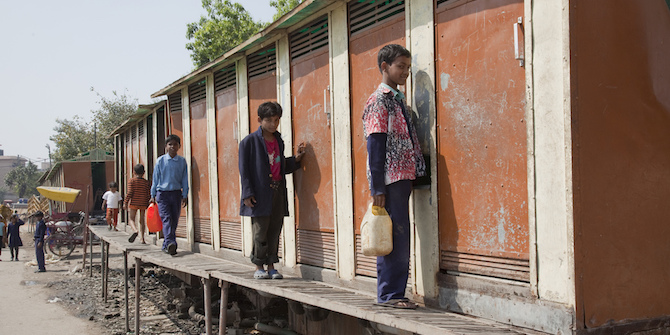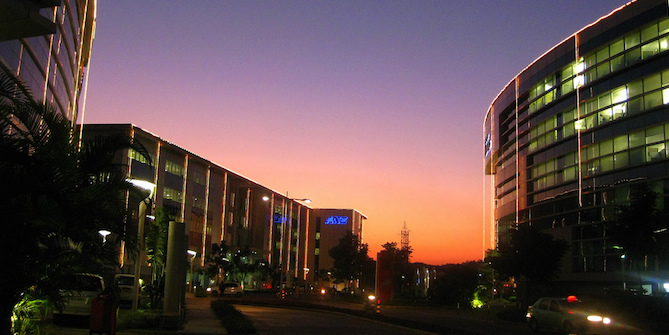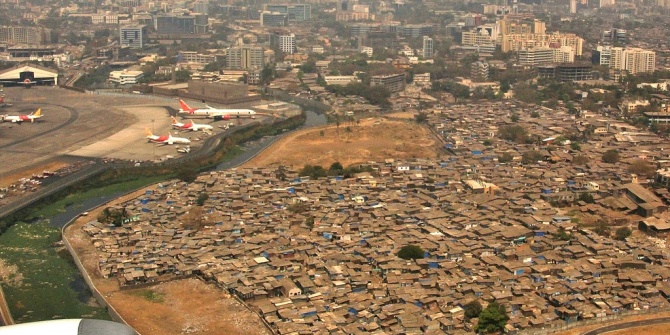Maratha Mook (Silent) Morchas are a unique form of collective agitation by a socially dominant but increasingly economically backward community in Maharashtra. This post examines their unique demand to be declared ‘backward’ by the state government to improve their sliding economic status, directly challenging the idea that elite groups do not voluntarily abjure their elite status.
The recent ‘Maratha Mook Morchas’ (lit. ‘Maratha Silent Demonstrations’), though outwardly silent, are a dramatic and explosive articulation by the dominant Maratha community in Maharashtra for Reservation and resurrection of their socio-economic status through street demonstrations. These silent demonstrations articulate the collective mind, anger, and angst of the community, and also displays their warrior pride with dignity.
Maratha demand for Reservation is not new but has been consistently rejected by different government Commissions in the last several decades. The larger context of the current dissent are the unprecedented socio-economic changes in India since economic liberalisation began in the early 1990s, though the immediate trigger for the mook morchas was the Kopardi incident in 2016, where a Maratha girl was raped and murdered by men allegedly belonging to the Dalit community. Kopardi provided the Marathas with the ‘moment’ to unite, mobilise and galvanise on an unprecedented scale: they organised more than 50 mook morchas in 2016–17 across Maharashtra, where hundreds of thousands participated with vigour, and with support and sympathy from other communities. The state responded by allocating 12 per cent and 13 per cent Reservation for Marathas in education and public services employment respectively through an Enactment of the state government in 2018, which was then challenged by Jishri Laxmanrao Patil in the Supreme Court of India. The second round of Maratha agitation started in reaction to the September 2020 judgement by the Supreme Court of India to refer the case to a larger bench and to stay the Reservation provided by the Enactment of 2018.
India’s economic liberalisation fundamentally altered the dynamics of the Indian economy, resulting in phenomenal economic growth for several years. The new economic environment led to tumultuous changes in the traditional Indian social order where the Hindu caste system still determines social status and societal stratification. Several hitherto socially dominant groups — like the Marathas in Maharashtra — felt their dominance challenged as the liberal economy opened access and opportunity to everyone across the social spectrum. Former ‘lower’ and ‘depressed’ groups became active beneficiaries of economic prosperity, openly challenging the earlier social order. This transition led to dissent and, eventually, agitations by the dominant communities in a country where caste remains an inseparable part of social interaction, and as such is a powerful tool of electoral mobilisation in India’s democracy.
This dissent, a direct outcome of India’s economic prosperity, has perplexed both academics and policy makers, necessitating the need for a better understanding of the evolving social phenomena now visible. To understand this better, we need to locate the mook morchas in its socio-historical context.
Caste: Its Economics and Politics
The Maratha-Kunbi caste cluster, traditionally an agrarian community of around 40 million, comprises 33 per cent of the population in Maharashtra, and has been dominant since the formation of the state of Maharashtra in 1960. The Marathas’ subtle understanding with the then ruling Congress Party gave them a long overdue share in economic and political resources. Creating a homogeneous Maratha-Kunbi cluster worked as a strategy for the Congress Party to win successively in competitive electoral politics in the state until the formal recognition of a new group — ‘Other Backward Castes’ (OBC) — in the early 1990s, following the nationwide implementation of the Report of the Mandal Commission. Maratha dominance in Maharashtra’s is visible variously: in elections since the formation of Maharashtra state, the Marathas have consistently won nearly 50 per cent of the non-Reserved seats in the state’s Legislative Assembly, excluding the constituencies reserved for Scheduled Castes (29 seats) and Scheduled Tribes (25 seats) respectively; in 54 of the 288 Legislative Assembly seats, even without any reservation, only Marathas have always been elected; of Maharashtra’s 18 Chief Ministers since 1960, 12 have been Marathas; most of the cooperative sugar factories are headed and/or are managed by Marathas, while Marathas are Chairpersons in 23 district-level Cooperative banks; about 71.4 per cent of cooperative institutions in Maharashtra are under the control of this community; all milk cooperatives and cotton mills are either owned or controlled by them; and finally, 75 to 90 per cent of the agricultural land in the state is owned by them.
From the early 1990s, however, this overarching Maratha dominance saw a downward spiral as it confronted the economic rise of other social groups due to economic liberalisation, the decline of the one-Party political system, and the rise of coalition politics. The Maratha-Kunbi population obviously resented this loss of dominance, but their dissent has largely been silent, except for a few sporadic violent incidents. The three key elements that have come to define Maratha demonstrations expressing dissent are — they are silent; young women are at the helm; and political leaders are consciously denied an active role, and kept at back end of the morchas. The disciplined and silent morchas follow a set formula: adolescent girls aged 14–20 years old, from whom five or six are selected and trained, address the audience with fiery emotional speeches from a small podium, a strategy that has connected effectively with the cause of the tragic Kopardi victim. Notably, there are no identifiable leaders of the agitation or the morchas, nor any one particular organisation mobilising/guiding them (which are generally estimated to gather between 1–3 million people). A federation of over 50 Maratha organisations from all over the state give a call to march in a particular city, following which Marathas from all over the state converge on the selected venue.

Bird’s-eye view of a Mook Morcha, Kolhapur, 2016. © For copyright information, see below.
The most visible feature of these mook morchas are its focus away from the Marathas’ traditional anti-Brahmin stance to being anti-Dalit. In 2016, the principal demand of the mook morcha was the withdrawal of the ‘Scheduled Castes and Scheduled Tribes Prevention of Atrocities Act 1989’ (in response to the Kopardi rape incident which had triggered these morchas); the repeal of the Act was, thus, central to the agitation. There were demands for Reservation of public sector jobs and seats in educational institutions for Marathas as well, but the real issue was the increased presence of Dalits in public spaces, and their concomitant upward educational and economic mobility enabled by the Reservation system. Dominant communities across India — including the Marathas in Maharashtra — had never imagined that education or non-farming/service sector jobs would ever topple social power equations one day.
The Maratha community’s economic and political fortunes has since been marked by dwindling returns from agriculture, fragmentation of landholdings, loss of traditional dignity associated with agriculture, lack of attention to educational training of the youth, etc leading to resentment towards communities who have ‘advantage’ (i.e., OBCs, Dalits) due to the national policies on Reservation. The situation became grim post-1991 when economic reforms further eroded the dominance of the Marathas. The cumulative effect of these factors led to the Marathas experiencing progressive deprivation, even though the realisation of backwardness due to decline of agriculture and fragmentation of landholdings took some time to concretise into collective action.
In comparison, the Dalits and OBCs were deeply influenced by the principles of their leader Dr B. R. Ambedkar who hailed that education alone could emancipate them out of discrimination and disadvantage. Quality higher educational institutions in urban areas benefitted Dalits and OBCs due to the reservation of places for them, and who earnestly believed in the power of education as a tool to pull them out of their historical poverty and deprivation. The Marathas, on the other hand — with their traditional and symbiotic relationship to land — did not idealise the same vision, continuing to believe that power accrued from their customary ownership of land. It is in this processual context over the years that average Marathas became educationally regressive, further widening the educational distance between themselves and the Dalit-OBC groups.
With economic liberalisation and reforms, and the attendant boom in the service sector which now became the principal motor of individual economic prosperity and social mobility, agriculture lost its prominent position in the economic order in Maharashtra. Industrial and service sectors along with IT-driven enterprises started to propel the economy; knowledge and the Digital economy, along with e-commerce connected India to the global economy, as newer and newer industries in the Digital sector hegemonised interactions with the world economy. Education and knowledge became the central pillars of this new emerging economy. As a result, Marathas began to feel left out of this dynamic economic and social churning, worsening their financial status and slipping further into conditions of cognisant poverty.
Demanding ‘Backwardness’
The demand for Reservation as a solution to bridge this growing economic distance therefore seemed an appropriate strategy to regain the lost status of the Marathas. They now believed that Reservation in education, public employment and political space enabled the backward communities to gain better economic status and would likewise do the same for them. This concept of ‘reverse’ aspiration defines this increasing tendency to demand ‘backwardness’ (by asking for Reservation of places for themselves, and therefore making themselves at par with traditional ‘lower’/‘depressed’ social groups) by this dominant and ‘forward’ group since the communities who have had the advantages of Reservation seem to have improved economically, and their upward economic mobility has provided access to more resources and better social status.
Thus, the reasons for the participation of the Marathas in the mook morchas is a result of the conscious build-up of their idea of social and economic loss and deprivation. Class consciousness is strengthened by kinship bonds in the community as they set out to articulate their demands. Traditional dress and colour (bhagava) codes, display of swords, symbols associated with Maratha culture amplify both kinship and community consciousness. But it is important to note that this is a latent consciousness as is not directly related to economic well-being or educational disadvantage: the consciousness is more political in nature. This demand for backward status, expressed through silent demonstrations, fundamentally topples elite, post-Marxist theories that argue that traditional elites do not necessarily give away their position of dominance easily.

Marathas in traditional attire at a Mook Morcha, Thane, August 2018; the inscription on their cap says ‘Ek Maratha, Lakh Maratha’ (lit. ‘1 Maratha, 100,000 Marathas’). © For copyright information, see below.
The Maratha Mook Morchas’ articulation of demands and state response to it will have long- lasting impact and implications. Similarly ‘deprived’ communities across India will agitate/demonstrate and start asserting economic backwardness by using the sheer strength of their numbers, and state governments may respond in the same vein. Success of the agitation will mean a shift in the narrative of Reservations which was designed in a framework of deprivation for ‘outcastes’, untouchability, social discrimination and disadvantage; the new social realities of the effects of the liberalisation of India’s economy will need to be acknowledged; social order will undergo change and, in the long run, the basic social stratification will perhaps need to self-adjust to reflect the new economic scenario. Most importantly, the shift in loyalties of the dominant communities resulting from support/opposition to the community’s demands will mean realignment of political support bases of the mainstream political parties. Against this possible background, the Maratha Mook Morchas can be seen as a milestone and turning-point in Indian polity.
© All 3 photographs Rajagopal Devara.
This article gives the views of the author, and not the position of the South Asia @ LSE blog, nor the London School of Economics and Political Science.








A well researched and well-presented article on the present situation of Indian Polity where the dominant castes are demanding backwardness to avail reservations.
Very thought provoking! Reminds me of ‘He mor durbhaga desh ‘ by Tagore